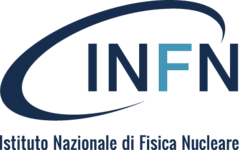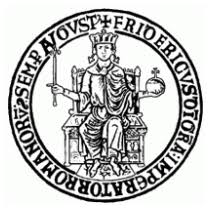14th International Spring Seminar on Nuclear Physics: "Cutting-edge developments in nuclear structure physics"
Ischia
This Seminar is the fourteenth in a series of topical meetings started in 1986 on the initiative of Aldo Covello. The main aim of the Seminar is to focus on the progress made in recent years from both a theoretical and experimental point of view as well as on the role that nuclear structure may play in the context of fundamental physics.
The Seminar will maintain the general spirit and intent of the earlier meetings of this series by providing to a group of researchers the opportunity to discuss their current work and confront their opinions.
Via M. Mazzella, 70 80077 Ischia
Main topics
- New frontiers in nuclear many-body theory and nuclear forces
- Experimental progress in nuclear structure studies
- Nuclear physics for testing fundamental physics
- Nuclear astrophysics
- Quantum computing and machine learning for nuclear physics
Local organizing committee:
Sponsored by





-
-
1
Registration
-
2
WELCOME
-
Morning Session 1Convener: Luigi Coraggio (INFN-NA)
-
3
Shell model meets in-beam gamma-ray spectroscopy on both sides of the nuclear chartSpeaker: Alexandra Gade (Facility for Rare Isotope Beams)
-
4
Structure of the calcium isotopes: past problems and future prospectsSpeaker: B. A. Brown (Facility for Rare Isotopes, Michigan State University, East Lansing, Michigan)
- 5
-
6
Updates on the relativistic nuclear field theory: refining dynamical kernels of the nuclear response
I will present selected results on nuclear giant and pygmy resonances at zero and finite temperatures based on the recent advancements of the nuclear many-body theory [1-6]. The theory will be compactly introduced in the most general quantum field theory formalism with only the bare fermionic interaction input. A special focus will be placed on the emergent scale of the quasiparticle-vibration coupling (qPVC) with the order parameter associated with the qPVC vertex and an efficient treatment of the nuclear many-body problem organized around the qPVC hierarchy [1-3].
Self-consistent solutions of the relativistic Bethe-Salpeter-Dyson equation for the nuclear response function in medium-heavy nuclei will be presented and discussed. Low-multipole neutral and charge-exchange resonances in calcium, nickel, and tin mass regions will be analyzed in the context of the role of high-complexity configurations in reproducing spectral data [2,3,7]. Finite-temperature theory and implementations for astrophysically relevant low-energy dipole strength, beta decay rates, and electron capture rates will be overviewed in light of the temperature dependence of the nuclear spectral properties [4,5].
References
[1] E. Litvinova and Y. Zhang, Microscopic response theory for strongly-coupled superfluid fermionic systems, Phys. Rev. C 106, 064316 (2022).
[2] E. Litvinova, On the dynamical kernels of fermionic equations of motion in strongly-correlated media, Eur. Phys. J. A59, 291 (2023).
[3] J. Novak, M. Q. Hlatshwayo, and E. Litvinova, Response of strongly coupled fermions on classical and quantum computers, arXiv:240502255.
[4] E. Litvinova and H. Wibowo, Finite-temperature relativistic nuclear field theory: an application to the dipole response, Phys. Rev. Lett. 121, 082501 (2018).
[5] E. Litvinova, C. Robin, and H. Wibowo, Temperature dependence of nuclear spin-isospin response and beta decay in hot astrophysical environments, Phys. Lett. B800, 135134 (2020).
[6] S. Bhattacharjee and E. Litvinova, Response of superfluid fermions at finite temperature, arXiv:2412.20751.
[7] M. Markova, P. von Neumann-Cosel, and E. Litvinova, Systematics of the low-energy electric dipole strength in the Sn isotopic chain, Phys. Lett. B860, 139216 (2025).Speaker: Elena Litvinova (Western Michigan University)
-
3
-
10:50
Coffe Break
-
Morning Session 2Convener: Antonio D'Onofrio (Istituto Nazionale di Fisica Nucleare)
-
7
Highlights from INFN-LNL, the Status and the Future plans of the SPES projectSpeaker: Tommaso Marchi (INFN - LNL)
-
8
Extrapolation and emulation techniques for few-body resonancesSpeaker: Sebastian Koenig (NC State University)
-
9
Electromagnetic properties of atomic nuclei: the path to collectivity and the nature of pre-collective nucleiSpeaker: Andrew STUCHBERY (The Australian National University)
- 10
-
11
Shape Coexistence in the N≃60 isotopes in the Sr-Ru regionSpeaker: Paul Garrett (University of Guelph)
-
7
-
13:25
Lunch
-
Afternoon Session 1Convener: Didier Beaumel (IJCLab)
-
12
Collectivity, shape coexistence and isomerism in lanthanide nuclei close to the proton drip lineSpeaker: Costel Petrache (University Paris-Saclay, IJCLab-CNRS/IN2P3)
-
13
Probing neutrinoless double-beta decay by nuclear observablesSpeaker: Lotta Jokiniemi (TRIUMF / TU Darmstadt)
- 14
-
15
Ordinary Muon Capture of sd-shell nuclei within the Realistic Shell ModelSpeaker: Songlin Lyu (Istituto Nazionale di Fisica Nucleare)
-
12
-
16:20
Coffee Break
-
Afternoon Session 2Convener: Peter Ring (Physics Department, Technical University Munich, D-85748 Garching, Germany & State Key Laboratory of Nuclear Physics and Technology, School of Physics, Peking University, Beijing 100871, China)
-
16
While waiting for γ beams at ELI-NP: The ELIGANT campaigns at IFIN-HH and at ELI-NPSpeaker: Dimiter L. Balabanski (Extreme Light Infrastructure - Nuclear Physics, IFIN-HH, Magurele, Romania)
-
17
Algebraic treatment of α-cluster nucleiSpeaker: Dr Roelof Bijker (ICN-UNAM)
-
18
Nuclear Structure Investigations in the A ≈ 30 Mass RegionSpeaker: Dimitar Tonev (Institute for Nuclear Research and Nuclear Energy, Sofia, Bulgaria)
-
19
Shell model understanding of nuclear isomerismSpeaker: Bhoomika Maheshwari (GANIL, France)
-
16
-
1
-
-
Morning Session 1Convener: A. Gade (Facility for Rare Isotope Beams, Michigan State University, East Lansing, Michigan, 48824, USA)
-
20
Taking Photos of the Nuclear Giant Dipole ResonanceSpeaker: Norbert Pietralla (TU Darmstadt)
-
21
Improved Actions for Nuclear Effective Field TheoriesSpeaker: Ubirajara van Kolck (ECT*)
-
22
Variational methods with symmetry constraints for application of quantum computers to nuclear physicsSpeaker: Dr Denis Lacroix (IJCLab-Paris Saclay University)
-
23
Recent results within the sd and fpg shellsSpeaker: J.M. Allmond (Oak Ridge National Laboratory)
-
24
Nuclear electromagnetic properties from valence-space in-mediumSpeaker: Takayuki Miyagi (University of Tsukuba)
-
20
-
11:05
Coffee Break
-
Morning Session 2Convener: Paul Garrett (University of Guelph)
-
25
A comprehensive view of nuclear shapes, rotations and vibrations from fully quantum mechanical perspectivesSpeaker: Takaharu Otsuka (University of Tokyo, Tokyo, Japan)
- 26
-
27
Few-nucleon correlations near and beyond the neutron drip-lineSpeaker: Tomohiro Uesaka
-
28
Assessing Spectral Shape of Forbidden Beta Decays with ACCESSSpeaker: Dr Lorenzo Pagnanini (Gran Sasso Science Institute & INFN - LNGS)
-
29
Precision nuclear theorySpeaker: Christian Forssén (Chalmers University of Technology)
-
25
-
13:35
Lunch
-
Afternoon Session 1Convener: Elena Litvinova (Western Michigan University)
-
30
Energy Density Functionals for nuclei and astrophysical applicationsSpeaker: Gianluca Colo' (Istituto Nazionale di Fisica Nucleare)
-
31
Exploring nuclear structure near 100Sn with neutron knockout reactionsSpeaker: T. J. Gray (Department of Physics and Astronomy, University of Tennessee Knoxville, Tennessee 37966, USA & Physics Division, Oak Ridge National Laboratory, Oak Ridge Tennessee 37831, USA)
-
32
Structure and electric dipole response of open-shell nuclei from coupled-cluster theorySpeaker: Francesco Marino
- 33
-
30
-
16:20
Coffee Break
-
Afternoon Session 2Convener: Sebastian Koenig (NC State University)
-
34
The NUMEN project: a new way to provide data-driven information on neutrino-less double-beta decay nuclear matrix elementSpeaker: Alessandro Spatafora (INFN-LNS and University of Catania)
-
35
Recent progress in global optimizations of covariant energy density functionalsSpeaker: Anatoli Afanasjev (Mississippi State University)
-
36
Discrete Non-Orthogonal Shell Model: from mid-mass to heavy deformed nucleiSpeaker: Duy-Duc Dao
-
37
Ab Initio description of open-shell nuclei at polynomial costSpeaker: Alberto Scalesi
-
38
New findings on neutrinoless double beta decay nuclear matrix elements using IBM-2Speaker: Elina Kauppinen (University of Jyväskylä)
-
34
-
-
-
Morning Session 1Convener: Gianluca Colo' (Istituto Nazionale di Fisica Nucleare)
-
39
Exploring α-induced reactions: Direct measurements and their impact on Nuclear AstrophysicsSpeaker: Melina L. Avila Coronado (Argonne National Laboratory, USA)
-
40
Present and future of the most sensitive techniques for double beta decay searches: an overviewSpeaker: Matteo Biassoni (Istituto Nazionale di Fisica Nucleare)
-
41
Isospin Symmetric Island of inversion at the N=Z lineSpeaker: Frédéric Nowacki
-
42
Toward simulating the nuclear shell model in a quantum computerSpeaker: Javier Menendez (University of Barcelona)
-
43
Exotic structures and double-magicity at the proton drip-lineSpeaker: Giacomo De Angelis (Istituto Nazionale di Fisica Nucleare)
-
39
-
11:05
Coffee Break
-
Morning Session 2Convener: Gianluca Imbriani (Istituto Nazionale di Fisica Nucleare)
-
44
Nuclear Structure near Particle Thresholds - Evidence from Nuclear AstrophysicsSpeaker: Michael Wiescher (University of Notre Dame, USA)
-
45
Recent developments in electron scattering with quantum Monte Carlo methodsSpeaker: Garrett King
-
46
The AGATA campaign at LNL: nuclear structure from high-resolution γ-ray spectroscopySpeaker: Andrea Gottardo (Istituto Nazionale di Fisica Nucleare)
-
47
Probing two-body charge-exchange transition densities with heavy ion reactionsSpeaker: Maria Colonna (Istituto Nazionale di Fisica Nucleare)
-
48
A new underground measurement of the 14N(p,γ)15O reaction at Bellotti Ion Beam FacilitySpeaker: Alessandro Compagnucci (Istituto Nazionale di Fisica Nucleare)
-
44
-
13:40
Excursion
-
-
-
Morning SessionConvener: A. Gargano (INFN Napoli)
-
49
Gender equality in STEM careersSpeaker: Sara Pirrone (Istituto Nazionale di Fisica Nucleare)
-
49
-
Morning Session 1Convener: Maria Colonna (Istituto Nazionale di Fisica Nucleare)
-
50
Neutrinoless double-beta decay search with the LEGEND experimentSpeaker: Riccardo Brugnera (Istituto Nazionale di Fisica Nucleare)
-
51
Nuclear response functions with quantum (inspired) algorithmsSpeaker: Alessandro Roggero (Istituto Nazionale di Fisica Nucleare)
-
52
A weak entanglement approximation for nuclear structureSpeaker: Calvin Johnson (San Diego State University)
-
53
Search for a neutron dark decay in 6HeSpeaker: hervé savajols (GANIL)
-
50
-
11:10
Coffee Break
-
Morning Session 2Convener: Ubirajara van Kolck (ECT*)
-
54
Effective Field Theory approach for radiative corrections to superallowed beta decaysSpeaker: emanuele mereghetti (Los Alamos National Laboratory)
-
55
Fast-timing lifetime measurements of exotic nuclei with a large LaBr3(Ce) array: The first results from the IDATEN projectSpeaker: Hiroshi Watanabe (Beihang University / Center for Exotic Nuclear Studies)
-
56
Ab initio calculations for nuclear astrophysics and searches for new physicsSpeaker: Jason Holt
-
57
Shape coexistence in the superheavy nucleus 286NoSpeaker: Peter Ring (Physics Department, Technical University Munich, D-85748 Garching, Germany & State Key Laboratory of Nuclear Physics and Technology, School of Physics, Peking University, Beijing 100871, China)
-
54
-
13:20
Lunch
-
Afternoon Session 1Convener: Nicola Lo Iudice (Dipartimento di Fisica, Univerita di Napoli Federico II, 80126 Napoli, Italy)
-
58
Exploring nuclear structures beyond mean-field using radioactive isotope beamsSpeaker: Daisuke Suzuki (Department of Physics, the University of Tokyo)
-
59
Extended Random Phase Approximation (ERPA) with modern NN+NNN interactionsSpeaker: Frantisek Knapp (Institute of Particle and Nuclear Physics MFF Charles University, CZ-18000 Prague 8, V Holesovickach 2, Czech Republic)
-
60
A Quantum Annealing Protocol to Solve the Nuclear Shell ModelSpeaker: Emanuele Costa (University of Barcelona)
-
61
Ab initio effective operator with continuumSpeaker: Zhicheng Xu (Fudan University)
- 62
-
58
-
16:40
Coffee Break
-
Afternoon Session 2Convener: Costel Petrache (University Paris-Saclay, IJCLab-CNRS/IN2P3)
-
63
Odd-mass Nb isotopes as a region of intertwined quantum phase transitionsSpeaker: Prof. Amiram Leviatan (The Hebrew University)
-
64
The first applications of the relativistic Second Tamm-Damncoff approximation in doubly-magic nucleiSpeaker: Deni Vale (Istrian University of Applied Sciences, Preradovićeva 9D, 52100 Pula, Croatia)
-
65
Shape coexistence in medium-mass nucleiSpeaker: Dorian Frycz (University of Barcelona)
-
66
Some insights on the He-4 mysteries from a- scattering measurementsSpeaker: Vasileios Soukeras (Istituto Nazionale di Fisica Nucleare)
-
63
-
Social Dinner
-
-
-
Morning Session 1Convener: Calvin Johnson (San Diego State University)
-
67
Pygmy resonance above excited statesSpeaker: Jan Kvasil (Institute of Particle and Nuclear Physics MFF Charles University, CZ-18000 Prague 8, V Holesovickach 2, Czech Republic)
-
68
Freedom in the chiral three-nucleon force at N3LOSpeaker: Luca Girlanda (Istituto Nazionale di Fisica Nucleare)
-
69
Nuclear Physics under the low-energy, high intensity frontierSpeaker: Chieh-Jen Yang
-
70
Direct and two-step processes in single charge exchange reactions within a unified modeSpeaker: Bakytzhan Urazbekov
-
71
Emulating hadronic matter in extreme conditionsSpeaker: Massimo Mannarelli (Istituto Nazionale di Fisica Nucleare)
-
72
Uncovering the mechanism of chiral three-nucleon force in driving spin-orbit splittingSpeaker: Tokuro Fukui (Kyushu University)
-
67
-
11:25
Coffee Break
-
Morning Session 2Convener: Giacomo De Angelis (Istituto Nazionale di Fisica Nucleare)
-
73
Description of Double Beta Decay within EMPM and STDASpeaker: Petr Vesely (Nuclear Physics Institute, Czech Academy of Sciencies, 25068 Rez, Czech Republic)
-
74
High-Precision Determination of Radiative Corrections to Superallowed Nuclear Beta DecaysSpeaker: Chien Yeah Seng (FRIB and University of Washington)
-
75
Approaching 100Sn: Structural evolution in 98,100Cd via lifetime measurementsSpeaker: Marta Polettini (GSI Helmholtzzentrum für Schwerionenforschung)
-
76
Radioisotopes for monitoring the effects of Climate Change on marine Ecosystems: the REMO/ClimOcean project at SPES/LNL RIB facilitySpeaker: Fanfei Zeng
-
73
-
